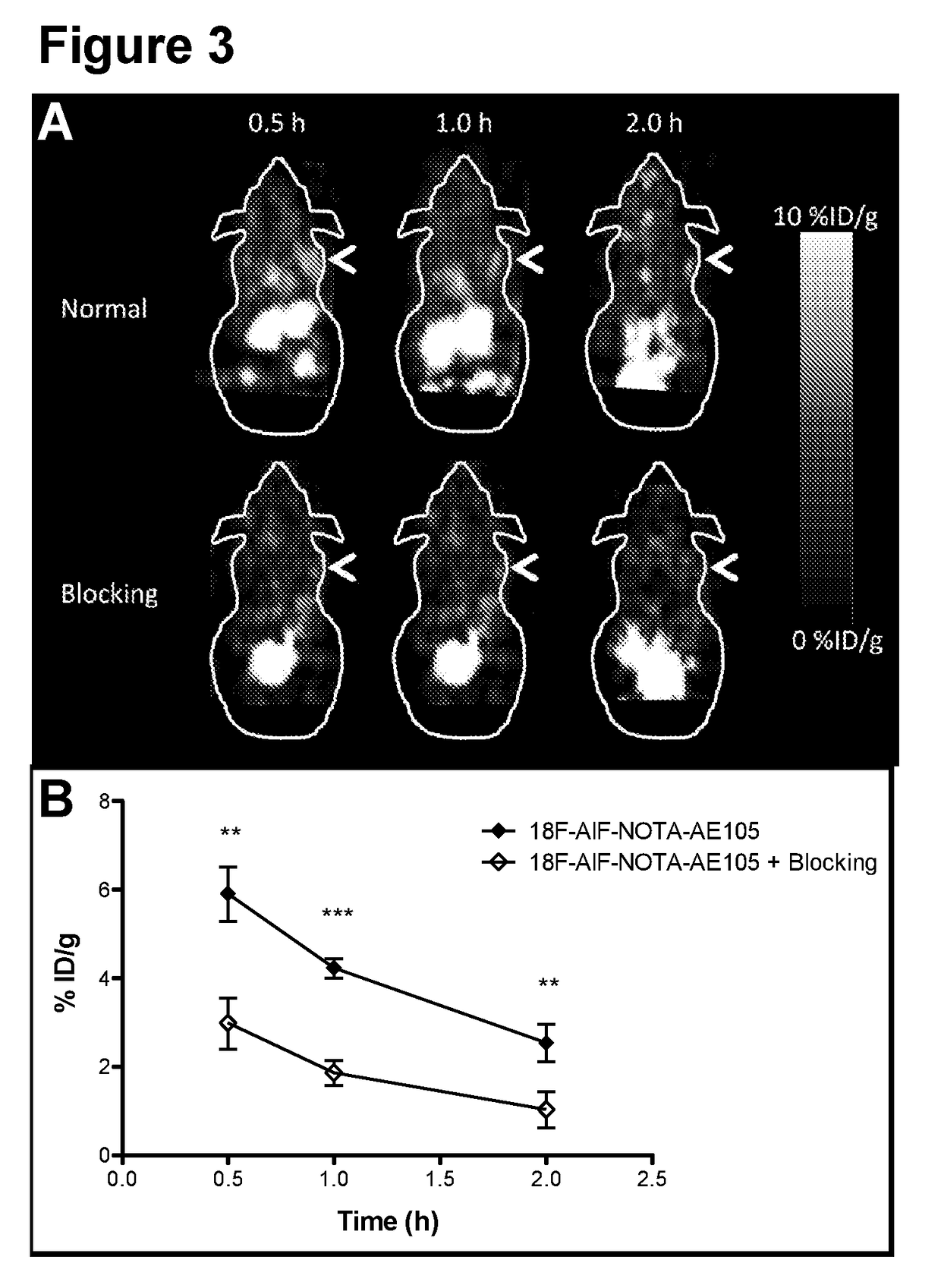Positron emitting radionuclide labeled peptides for human uPAR PET imaging
a radionuclide and peptide technology, applied in the direction of peptide/protein ingredients, radiation therapy, therapy, etc., can solve the problems of local invasion or metastasis, and achieve the effect of superior in vivo characteristics of upar pet ligands, high tumor-to-background ratio, and high tumor uptak
- Summary
- Abstract
- Description
- Claims
- Application Information
AI Technical Summary
Benefits of technology
Problems solved by technology
Method used
Image
Examples
example 1
[0064]The aim of the present study was to synthesize a NOTA-conjugated peptide and use the Al18F method for development for the first 18F-labeled PET ligand for uPAR PET imaging and to perform a biological evaluation in human prostate cancer xenograft tumors. To achieve this, the present inventors synthesized high-affinity uPAR binding peptide denoted AE105 and conjugated NOTA in the N-terminal. 18F-labeling was done according to a recently optimized protocol26. The final product (18F—AlF-NOTA-AE105) was finally evaluated in vivo using both microPET imaging in human prostate tumor bearing animals and after collection of organs for biodistribution study.
Chemical Reagents
[0065]All chemicals obtained commercially were of analytical grade and used without further purification. No-carrier-added 18F-fluoride was obtained from an in-house PETtrace cyclotron (GE Healthcare). Reverse-phase extraction C18 Sep-Pak cartridges were obtained from Waters (Milford, Mass., USA) and were pretreated w...
example 2
[64Cu]NOTA-AE105 (NOTA-Asp-Cha-Phe-Ser-Arg-Tyr-Leu-Trp-Ser-OH)
[0087]64CuCl2 dissolved in 50 ul metal-free water was added to a solution containing 10 nmol NOTA-AE105 and 2.5 mg gentisic acid dissolved in 500 ul 0.1 M NH4OAc buffer (pH 5.5) and left at room temperature for 10 minutes resulting in 375 MBq [64Cu]NOTA-AE105 20 with a radiochemical purity above 99%. The radiochemical purity decreased to 94% after 48 hours storage.
example 3
In Vivo uPAR PET Imaging with [64Cu]NOTA-AE105 in a Orthotropic Human Glioblastoma Mouse Model
[0088]A mouse was inoculated with human derived glioblastoma cells in the brain. 3 weeks later a small tumor was visible using microCT scan A microPET images was recorded 1 hr post i.v. injection of approximately 5 MBq [64Cu]NOTA-AE105. Uptake in the tumor and background brain tissue was quantified. Moreover, was a control mouse (with no tumor inoculated) also PET scanned using the same procedure, to investigate the uptake in normal brain tissue with intact blood brain barrier. See FIG. 6.
PUM
| Property | Measurement | Unit |
|---|---|---|
| pore size | aaaaa | aaaaa |
| v/v | aaaaa | aaaaa |
| tissue density | aaaaa | aaaaa |
Abstract
Description
Claims
Application Information
 Login to View More
Login to View More - R&D
- Intellectual Property
- Life Sciences
- Materials
- Tech Scout
- Unparalleled Data Quality
- Higher Quality Content
- 60% Fewer Hallucinations
Browse by: Latest US Patents, China's latest patents, Technical Efficacy Thesaurus, Application Domain, Technology Topic, Popular Technical Reports.
© 2025 PatSnap. All rights reserved.Legal|Privacy policy|Modern Slavery Act Transparency Statement|Sitemap|About US| Contact US: help@patsnap.com



